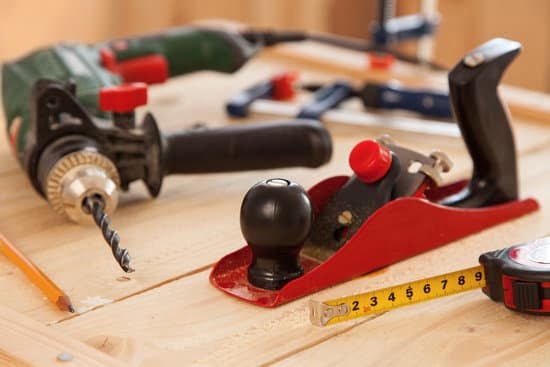Woodworking is a craft that requires careful consideration and planning, particularly when it comes to selecting the right tools for the job. One crucial aspect of woodworking is choosing the appropriate router size. A router, a versatile power tool commonly used in woodworking, comes in various sizes, each with its own set of strengths and capabilities. It’s important to identify the ideal router size to ensure optimal performance and successful completion of projects.
The size of the router plays a significant role in determining its functionality and usability. Since different woodworking tasks require different levels of power, speed, and precision, having the right size router becomes essential for achieving desired results. Whether you are a beginner embarking on your first project or an experienced woodworker looking to upgrade your arsenal, knowing what size router you need is vital.
Understanding the basics of what size router is suitable for woodworking involves exploring the different types and sizes available in the market. From compact palm routers to larger plunge or fixed-base routers, each category offers its own unique features and applications. Familiarizing yourself with these options will empower you to make an informed decision based on your specific woodworking needs.
When evaluating project requirements, it is crucial to match the router’s size with the tasks at hand. Considering factors such as project complexity, material thickness, and desired level of detail helps determine whether a smaller trim router or a more powerful heavy-duty router would be most appropriate. By aligning your choice with your projects’ demands, you can ensure smooth operations and high-quality results every time.
Understanding the Basics
When it comes to woodworking, one of the most important decisions you’ll need to make is choosing the right size router for your projects. Understanding the basics of router sizes and types is crucial in order to achieve optimal results in your woodworking endeavors.
Types of Routers
Before determining the size of router you need, it’s essential to understand the different types available in the market. There are mainly three types of routers commonly used in woodworking: plunge routers, fixed-base routers, and trim routers.
Plunge routers have a spring-loaded base that allows you to plunge the bit into the wood, making them ideal for tasks like creating decorative grooves or cutting mortises. Fixed-base routers are versatile all-around tools that are typically mounted on a router table for added stability and precision. Trim routers, on the other hand, are smaller and more lightweight options designed for trimming edges and working with smaller pieces of wood.
Router Sizes
When considering what size router you need, it’s important to assess both the power rating and collet size. The power rating is usually measured in horsepower (HP), which determines how much force the router can exert while cutting through wood. Higher horsepower generally signifies a larger router capable of handling heavier tasks.
The collet size refers to the diameter of the bit shank that can be fitted into the chuck of the router. Common collet sizes include 1/4-inch and 1/2-inch, with larger diameters providing increased stability and durability during use.
It’s also worth noting that larger routers tend to have bigger bases, allowing for more stability while routing along longer edges or when working with larger workpieces. However, bigger does not always mean better – smaller routers offer increased maneuverability and are often preferred for delicate or intricate work.
Understanding these basic concepts regarding types and sizes of routers will help set you on the right path when it comes to selecting the ideal router for your woodworking projects. In the next section, we will delve into evaluating project requirements and matching them to the appropriate router size.
Evaluating Project Requirements
When it comes to choosing the right size router for your woodworking projects, it is essential to evaluate your project requirements and match the router size to the tasks at hand. This step is crucial because using the wrong size router can affect the quality and efficiency of your work. Here are some factors to consider when evaluating your project requirements and selecting the appropriate router size:
- Project Complexity: Consider the complexity of your woodworking projects. If you primarily work on small-scale projects such as making jewelry boxes or intricate carvings, a compact or palm-sized router may be suitable. These routers provide better precision and control for detailed work. However, for larger-scale projects like building furniture or cabinetry, a full-sized router with more power and cutting capacity may be necessary.
- Depth of Cut: Evaluate the depth of cut required for your woodworking tasks. Some routers have limited plunge depth, which means they cannot handle deep cuts in thicker materials. For example, if you frequently need to make deep grooves in hardwood or thick panels, a router with a greater plunge capacity is recommended.
- Router Stability: Consider the stability of your workpiece during routing. If you often work with smaller or irregularly shaped pieces that require handheld routing, a lighter and more maneuverable trim or palm-sized router might be ideal. On the other hand, working on larger stock like wide boards or heavy timbers will benefit from a heavier and more stable fixed-base or plunge router.
To assist you in making an informed decision when evaluating project requirements for matching the router size, here is an unordered list summarizing these considerations:
- Complexity of project.
- Depth of cut required.
- Stability of workpiece.
By carefully assessing these factors specific to each woodworking task, you can ensure that you select a router size that meets your needs and produces high-quality results.
Determining Workpiece Size and Router Capacity
When it comes to choosing the right size router for your woodworking projects, one important factor to consider is the capacity of the router in relation to the size of your workpieces. Assessing the router’s power and capability will ensure that it can handle the tasks you have in mind.
One way to determine a router’s capacity is by looking at its horsepower (HP) rating. The higher the horsepower, the more powerful the router will be. This is particularly important for larger workpieces or when using hardwoods that require more cutting power. However, it’s worth noting that higher horsepower routers tend to be bulkier and heavier, which may impact maneuverability.
Another factor to consider is the speed range of the router. Different projects may require different speeds for optimal results. For example, when using larger bits or working with harder woods, slower speeds are generally preferred as they reduce overheating and give you more control over your cuts.
In addition to horsepower and speed range, it’s also important to consider other features that can affect a router’s capacity. These include plunge depth, maximum bit diameter, and collet size.
Plunge depth refers to how deep a cutting bit can penetrate into your workpiece, while maximum bit diameter indicates the largest size bit that can be used with a particular router model. Collet size is important because it determines the type of shank that can be used with a specific router.
| Specs | Description |
|---|---|
| Horsepower (HP) | The measurement of a motor’s power, indicating the cutting capacity of a router. |
| Speed Range | The range of rotational speeds at which the router can operate, affecting the quality and control of cuts. |
| Plunge Depth | The maximum depth that the router’s cutting bit can penetrate into the workpiece. |
| Maximum Bit Diameter | The largest size of bit that can be used with a particular router model. |
| Collet Size | The size and type of shank that can be used with a specific router. |
By evaluating these specifications and considering your woodworking projects’ requirements, you can determine what size router is best suited to meet your needs. It’s important to remember that choosing a router with adequate power and capability will not only ensure optimal performance but also enhance safety by preventing strain on the tool and reducing the risk of kickback.
Choosing the Right Bits
When it comes to choosing the right router for woodworking, another important factor to consider is the size of the router bits. The size of the router bits you use can have a significant impact on the overall performance and quality of your woodworking projects.
Router bits come in a variety of sizes, shapes, and designs, each suited for specific woodworking tasks. The two main factors to consider when selecting router bits are their diameter and their shank size.
The diameter of the router bit refers to the width or cutting capacity of the bit. Smaller diameter bits are typically used for delicate and intricate work, such as decorative edging or detail routing. On the other hand, larger diameter bits are ideal for creating wide cuts or shaping larger surfaces.
The shank size of a router bit refers to the diameter of the portion that fits into the collet of the router. Most routers can accommodate both 1/4-inch and 1/2-inch shank sizes. Generally, larger shank sizes provide more stability and less vibration during operation, resulting in smoother and cleaner cuts.
To choose the right size of router bits for your woodworking projects, you need to consider both the desired outcome and the capabilities of your chosen router. It’s essential to match your router’s collet size with the appropriate shank size of your desired router bits.
| Router Bit Size | Recommended Woodworking Tasks |
|---|---|
| 1/4-inch | – Detail routing\n – Trim work\n – Edge profiling\n – Joinery\n – Inlaying |
| 1/2-inch | – Creating wider grooves\n – Raised panel doors\n – Large-scale joinery\n – Shaping bigger surfaces |
Choosing the right size of router bits is crucial for achieving the desired results in your woodworking projects. Using a router that is compatible with various bit sizes opens up more possibilities and flexibility in your work.
It is also important to ensure that your router has enough power and stability to handle the larger bits, as they can put more strain on the motor. Understanding how the size of router bits affects the overall performance allows you to make informed decisions and create high-quality woodworking pieces.
Assessing Comfort and Maneuverability
When selecting a router for woodworking, it is important to consider not only the size and power of the tool, but also its comfort and maneuverability. The size and weight of the router can greatly impact the overall user experience, especially during long hours of use or when working on intricate projects. In this section, we will delve into how the size and weight of the router can affect user comfort and maneuverability.
User Comfort: Finding a Router That Fits Your Grip
One important aspect of assessing comfort in a router is evaluating how well it fits your grip. Different individuals have different hand sizes and shapes, so it is crucial to choose a router that feels comfortable and natural in your hands. Look for routers with ergonomic handles that provide a secure grip and reduce strain on your hand and wrist during extended use.
Additionally, consider the placement of controls on the router. Ideally, these should be easily accessible without requiring you to adjust your grip or strain your fingers. Some routers feature adjustable handles that allow you to find the most comfortable position for your hand.
Maneuverability: Balancing Size with Versatility
The size of the router can also affect its maneuverability, especially when working on intricate projects or tight spaces. A larger, bulkier router may be difficult to control in these situations, whereas a smaller and more compact option can offer better maneuverability.
However, it is essential to strike a balance between size and versatility. Smaller routers may offer enhanced maneuverability but could lack the power needed for certain tasks or require additional accessories for routing larger workpieces. Therefore, consider both the type of woodworking projects you typically undertake and any future projects you envision when assessing the ideal size for your purposes.
Budget Considerations
When it comes to selecting a router for woodworking, one of the key factors that should be considered is budget. Woodworking routers come in various sizes and prices, and it’s important to find the ideal balance between cost and functionality. Here are some considerations to keep in mind when making your decision.
- Assess your woodworking needs: Before deciding on a budget, it’s crucial to evaluate your specific woodworking requirements. Think about the types of projects you typically work on and the features you need in a router. If you are a beginner or only plan to tackle occasional projects, you may not need the most expensive or advanced router on the market.
- Research different brands and models: Once you have determined your woodworking needs, take the time to research different brands and models within your budget range. Look for routers that offer good value for money by considering factors such as durability, performance, and customer reviews.
- Consider long-term investment: While budget is important, it’s also essential to consider the long-term investment when selecting a router size. Think about how often you will be using the router and if there is potential for future projects that may require more capabilities. Investing in a higher-quality router now may save you money in the long run by avoiding the need for upgrades or replacement.
To help make your decision easier, here are two HTML unordered lists highlighting factors to consider when balancing cost and functionality:
Factors to consider when assessing your woodworking needs:
- Frequency of use.
- Types of projects.
- Desired features.
Factors to consider when researching different brands/models within your budget range:
- Durability/reliability.
- Performance.
- Customer reviews.
Remember, finding the ideal balance between cost and functionality is dependent on individual needs and preferences. It’s important to carefully evaluate these factors before making a final decision on what size router to purchase for your woodworking projects.
Expert Recommendations
When it comes to choosing the right size router for woodworking, experienced woodworkers offer valuable insights based on their years of hands-on experience. These experts understand that different woodworking applications require different router sizes in order to achieve optimal results.
For smaller woodworking projects such as trim work or delicate detailing, a compact palm router is often recommended. These routers are lightweight and versatile, making them easy to maneuver and control. They are also suitable for freehand designs or working with small workpieces where precision is crucial. However, when it comes to larger projects like cabinet making or creating furniture pieces, a mid-sized router with more power and stability may be required.
In addition to project size, the type of material being worked with should also be taken into consideration when selecting a router size. For softer woods like pine or cedar, a smaller router can handle the job efficiently.
However, harder woods such as oak or mahogany may require a larger and more powerful router to effectively cut through the dense material. Experts recommend considering both the density and thickness of the wood when choosing the appropriate router size for a specific woodworking task.
Overall, expert woodworkers emphasize the importance of understanding the specific requirements of each woodworking application before deciding on a router size. They encourage beginners to start with a versatile mid-sized model that offers a good balance between power and maneuverability before progressing to more specialized routers for specific tasks.
By seeking advice from experienced professionals in the field and experimenting with different router sizes, woodworkers can gain valuable insights and knowledge that will help them make informed decisions about what size router they need for their woodworking projects.
Troubleshooting and Common Mistakes
When it comes to selecting the right size router for woodworking, there are a few common mistakes and potential issues that woodworkers may encounter. By addressing these concerns and misconceptions, individuals can make a more informed decision about the size of router they need for their specific woodworking projects.
One common mistake that woodworkers make when selecting a router size is underestimating the power and capability required for their projects. It’s important to consider the demands of your woodworking tasks and choose a router with enough power to handle them effectively. For example, if you frequently work with hardwoods or large, thick pieces of wood, you will likely need a router with higher horsepower and torque to ensure smooth cuts and consistent results.
On the other hand, another misconception is that bigger always means better when it comes to routers. While larger routers often have greater power and capacity, they may not be necessary for every woodworking project. Oversized routers can be heavy and bulky, making them difficult to maneuver and control.
This can lead to errors or accidents during operation. It’s essential to evaluate both the size of your workpieces and your own comfort and maneuverability needs when deciding on a router size.
Additionally, many woodworkers overlook the importance of matching the size of their router bits with the overall performance of their projects. Different types of woodworking tasks require different types and sizes of router bits. Choosing the wrong bit size can result in poor quality cuts or damage to your workpiece. Before selecting a router size, it’s crucial to consider the range of bit sizes available for that particular model and ensure they align with your intended applications.
By addressing these potential issues and misconceptions, woodworkers can avoid common mistakes when selecting the size of a router for their woodworking projects. Taking into account factors such as project requirements, workpiece size, comfort, maneuverability, budget considerations, expert recommendations, and matching bits ensures that you find the ideal balance between cost-effectiveness and functionality. Always remember to research thoroughly and seek advice from experienced woodworkers before making a final decision on the size of router you need.
Conclusion
In conclusion, choosing the right size router for woodworking is a crucial decision that will greatly impact the outcome of your projects. Throughout this article, we have explored the different types and sizes of routers, as well as the factors to consider when matching them to your specific woodworking tasks.
One of the primary considerations when selecting a router size is evaluating project requirements. Depending on the complexity and scale of your woodworking tasks, you may need a smaller handheld router for more intricate work or a larger table-mounted router for heavy-duty tasks. By carefully assessing your needs, you can ensure that you have the appropriate power and capability to handle your projects effectively.
The size of router bits also plays a significant role in determining which router size to choose. Different bits require different speeds and depths of cut, so it is important to select a router size that can accommodate the necessary bit sizes for your desired results.
Additionally, comfort and maneuverability are critical factors to consider. The size and weight of the router will impact how easy it is to handle and manipulate during use. It is essential to choose a router that feels comfortable in your hand and allows for precise control over your cutting movements.
Ultimately, finding a balance between budget and functionality is key when selecting a router size. Consider both the initial cost of purchasing the tool and any potential long-term maintenance or upgrade expenses.
Frequently Asked Questions
Is 1 3 4 hp router enough?
Whether a 1 3/4 horsepower (HP) router is enough for your needs depends on the specific woodworking projects you plan to tackle. Generally, a 1 3/4 HP router is suitable for medium to large-sized projects and can handle many types of cuts and joinery work.
However, if you primarily work with harder materials or require higher torque for more demanding tasks, you might want to consider a more powerful router. It’s important to assess your specific woodworking requirements and match them with the appropriate power and features of the router.
How do I choose a woodworking router?
Choosing a woodworking router involves considering several factors to ensure you select the right tool for your needs. First, determine what type of projects you’ll be working on most frequently, as this will dictate the necessary power and size of the router. Consider the ergonomic design and comfort of use, as routers can be handheld or mounted on a table.
Assessing the available features like variable speed control, easy bit changes, and dust collection capabilities can help enhance functionality and convenience in your woodworking tasks. Additionally, considering the reputation of brands and their customer support is essential when selecting a reliable woodworking router.
What wattage router for woodworking?
The appropriate wattage for a woodworking router depends on various factors such as the type of wood you typically work with, project complexity, and desired precision. Typically, routers range in wattage from around 500 watts up to several thousand watts or even more for industrial applications. For general woodworking purposes like cabinetry or furniture making, a router within the range of 1000-2000 watts should suffice for most tasks.
However, more powerful routers may be necessary when working with denser hardwoods or engaging in heavy-duty shaping or cutting operations. It’s important to strike a balance between power requirements and considering other important features such as speed control options and overall durability when choosing a wattage for your woodworking router.

Hi everyone! I’m a woodworker and blogger, and this is my woodworking blog. In my blog, I share tips and tricks for woodworkers of all skill levels, as well as project ideas that you can try yourself.





